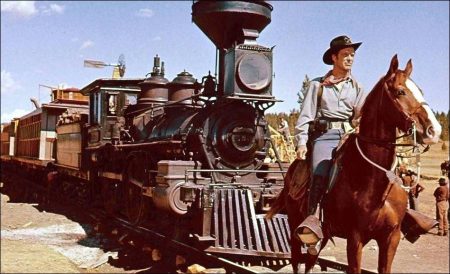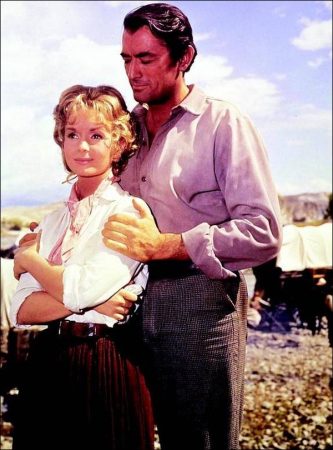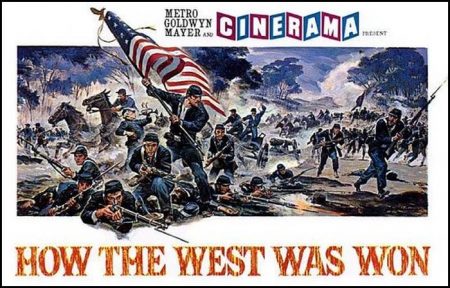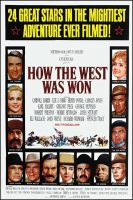How the West Was Won movie storyline. The story of how, over several generations, families opened up the Western U.S. to settlement. Zebulong Prescott, his wife Rebecca and daughters Eve and Lilith make the perilous journey, first down the newly built Erie Canal. Along the way they meet hunter and trapper Linus Rawlings, a genuine mountain man and catches Eve’s eye in particular. They go their separate ways but Linus helps them out again when river bandits try to rob the Prescotts of their earthly possessions.
A subsequent tragedy on the river however brings Eve and Linus together. Eve’s sister Lilith decides to leave as soon as possible but ends up meeting her man, Cleve Van Valen and they make their way to the West Coast where they make their fortune. Eve and Linus’ son Zeb fights in the Civil War and stays in the army afterward. He is assigned to protect the railroad, currently under construction. He sees the fear Indians have of the encroachment of white men onto their lands and the destruction of the buffalo. He makes a name for himself as a lawman and eventually agrees to take over his aunt Lilith’s ranch, but not before having to take on one last fight.
How the West Was Won is a 1962 American Metrocolor epic-western film.[4] The picture was one of the last “old-fashioned” epic films made by Metro-Goldwyn-Mayer to enjoy great success. The all-star cast includes Carroll Baker, Lee J. Cobb, Henry Fonda, Carolyn Jones, Karl Malden, Gregory Peck, George Peppard, Robert Preston, Debbie Reynolds, James Stewart, Eli Wallach, John Wayne, and Richard Widmark.
Set between 1839 and 1889, it follows four generations of a family (starting as the Prescotts) as they move from western New York to the Pacific Ocean. The picture was one of only two dramatic films made in the curved-screen three-projector Cinerama process, which added to its original impact. The film is narrated by Spencer Tracy. The score was listed at number 25 on the American Film Institute’s 100 Years of Film Scores. The film also gained widespread critical acclaim. In 1997, the film was selected for preservation in the National Film Registry of the Library of Congress as being deemed “culturally, historically, or aesthetically significant”.
Filmed in panoramic Cinerama, this star-studded, epic Western adventure is a true cinematic classic. Three legendary directors (Henry Hathaway, John Ford and George Marshall) combine their skills to tell the story of three families and their travels from the Erie Canal to California between 1839 and 1889. Spencer Tracy narrates the film, which cost an estimated $15 million to complete.
Westward expansion shows scenes of the Indian’s sorrow, the white man’s greed, river pirates, outlaws, lawmen, and life and death on the Western plains. Dozens of marquee names worked with over 12,000 extras, 630 horses, hundreds of horse drawn wagons, and a stampede of 2,000 buffalo. The human cost of the concept of Manifest Destiny is revealed in all its colorful and violent glory. How the West Was Won garnered three Oscars, for screenplay, film editing, and sound production.
How the West Was Won (1963)
Directed by: John Ford, Henry Hathaway, George Marshall
Starring: Carroll Baker, Walter Brennan, Lee J. Cobb, Andy Devine, Henry Fonda, Carolyn Jones, Karl Malden, Gregory Peck, George Peppard, Robert Preston, Debbie Reynolds, Thelma Ritter, James Stewart, Eli Wallach, John Wayne, Richard Widmark
Screenplay by: James R. Webb
Production Design by:
Cinematography by: William Daniels, Milton Krasner, Charles Lang
Joseph LaShelle
Film Editing by: Harold F. Kress
Costume Design by: Walter Plunkett, Ron Talsky
Set Decoration by: Henry Grace, Don Greenwood Jr., Jack Mills
Art Direction by: George W. Davis, William Ferrari, Addison Hehr
Music by: Alfred Newman
MPAA Rating: G for all audience.
Distributed by: Metro-Goldwyn-Mayer
Release Date: February 20, 1963 (United States)
Views: 244



